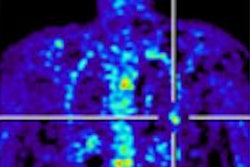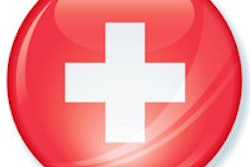
Researchers have demonstrated that software is as good as, if not better than, hardware when it comes to filtering out patient motion during PET. In blind tests of software- and hardware-gated PET images, reviewers could spot no difference most of the time, and when differences were seen, software gating was more likely to be rated as superior. The researchers believe the results could be a "game changer" for software-gated PET, which they say provides an easy and low-cost way to better PET scans.
PET is a technique for imaging metabolic processes using a positron-emitting tracer that's introduced into the body. The emitted positrons interact with electrons in tissue, generating a pair of gamma rays that can be recorded on a detector -- in turn revealing the exact position of the tracer.
One problem of PET is the scans are normally acquired over several minutes, which means that patient movement -- breathing, in particular -- can degrade images and make it harder for clinicians to spot abnormalities. The conventional way to tackle this problem is via hardware gating, taking the form of either a pressure belt or a horizontally mounted camera. By monitoring changes in pressure, or (with the camera) the movement of a block on the patient's chest, it is possible to separate scan data into different phases of the breathing cycle.
Hardware-based gating approaches bring their own difficulties, however. According to medical physicist Adam Kesner at the University of Colorado Denver, they require time to set up, they often fail, and are expensive. (Radiology, 30 March 2016)
"I think software gating can be a game changer," Kesner added. "There is real motion information in our data that we can have for 'free,' and we don't need to change hospital protocols to get it."
In software gating, the timing information already taken in a standard PET scan is analyzed with the image data to identify spatio-temporal fluctuations, which can then be combined to fully characterize the patient's motion. Kesner and colleagues hope to make others in the field realize this is a better technique, using their side-by-side tests of hardware- and software-gated images. In a large study of 116 patients who underwent PET scans for pulmonary abnormalities, they asked three reviewers to blindly assess the images generated by software and hardware gating and say which were the best.
The reviewers found more than 75% of the software-generated images were indistinguishable from their hardware-generated counterparts. When the pairs of images could be distinguished, the reviewers rated the software-gated ones as superior more than 70% of the time. "Our sample size was large enough to demonstrate this preference with statistical significance," Kesner noted.
"It is our hope that this work will open the minds of users, vendors, and leadership to the potential of software gating as a low-cost solution to the decades-old problem of motion degradation in PET," he continued. "The old adage that we are limited only by our imaginations holds particularly true in this area of innovation. While the concept of hardware gating may be simpler to understand, software gating is simpler to implement, requires no changes to clinical procedures and, overall, represents a smarter use of image data."
© IOP Publishing Limited. Republished with permission from medicalphysicsweb, a community website covering fundamental research and emerging technologies in medical imaging and radiation therapy.



















